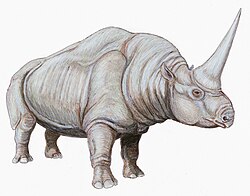Megahippus
| Megahippus Temporal range: Barstovian to Late Clarendonian | |
|---|---|
 | |
| Megahippus mckennai fossils | |
| Scientific classification | |
| Domain: | Eukaryota |
| Kingdom: | Animalia |
| Phylum: | Chordata |
| Class: | Mammalia |
| Order: | Perissodactyla |
| Family: | Equidae |
| Subfamily: | †Anchitheriinae |
| Genus: | †Megahippus McGrew, 1938 |
| Species | |
| |
Megahippus is an extinct genus of large Anchitheriine horses found throughout the southern portion of the United States during the middle Miocene. The animal represents one of the latest low-crowned horses, overlapping in time with more derived high-crowned horses.[1]
Description
[edit]Dentition
[edit]Though generally similar to other genera within the subfamily, Megahippus is unique in the presence of a well defined ridge across the inner edge of the premolars 1-3 along with the presence of large, frontward-facing lower incisors.[2] Unlike the incisors of other anchitheriines like Hypohippus, they would have been large and high-crowned.Between the two species, there is evidence of a trend of the animal's premolars shrinking over time with them being larger proportionally in M. mckennai.[3] Both Megahippus and Hypohippus show a general trend in the increase in frequency of conchets in their upper cheek teeth potentially due to the segregation of the section when compared to the earlier Anchitherium.[4]
Crania
[edit]Megahippus is generally comparable with other genera in the subfamily, having a short premaxilla that constricts before the first premolar. The infra-orbital fossa is located about the P4 with the facial fossa positioned above and behind the infra-orbital fossa. The placement of the facial fossa more similar to the more basal Archaeohippus than the closely related Hypohippus.[3]
Postcrania
[edit]The limb morphology of Megahippus is similar to those seen in living equines, having adaptations towards the restricted movement of the fetlock. Thought this seems to be a convergent adaption related to the support of larger body masses. The ungual of larger anchitheriins like Megahippus was also similar to Equus which would have given the animal a more rounded phalanx then smaller smaller genera.[5][6] Unlike modern horses, the feet of Megahippus and other anchitheriins were tridactyl.[7] The estimated body masses of the species of the genus are 194.9 kg for M. mckennai and 266.2 kg for M. matthewi.[8]
Paleobiology
[edit]Based on wear and morphology seen in the incisors of Megahippus, this animal was a more specialized browser than other genera.[9] During the time that the animal lived, the number of equid species in North America had massively decreased with only a few species being found throughout the continent and these species not being many numerous in their ecosystems.[10]
References
[edit]- ^ Radinsky, Leonard (1984). "Ontogeny and Phylogeny in Horse Skull Evolution". Evolution. 38 (1): 1–15. doi:10.2307/2408541. ISSN 0014-3820. JSTOR 2408541.
- ^ Stirton, R. A. (1941). "Development of Characters in Horse Teeth and the Dental Nomenclature". Journal of Mammalogy. 22 (4): 434–446. doi:10.2307/1374940. ISSN 0022-2372. JSTOR 1374940.
- ^ a b Tedford, Richard F.; Alf, Raymond M. (1962). "A NEW MEGAHIPPUS FROM THE BARSTOW FORMATION SAN BERNARDINO COUNTY, CALIFORNIA". California. Bulletin, Southern California Academy of Sciences. 61 (2): 113–122.
- ^ Forsten, Ann (1973). "The Evolution of Some Morphological Characters of the Upper Cheek Teeth of the Fossil Horses". Evolution. 27 (1): 36–43. doi:10.2307/2407117. ISSN 0014-3820. JSTOR 2407117.
- ^ Janis, Christine M.; Bernor, Raymond L. (2019-04-12). "The Evolution of Equid Monodactyly: A Review Including a New Hypothesis". Frontiers in Ecology and Evolution. 7. doi:10.3389/fevo.2019.00119. hdl:1983/ede09e37-96f7-4baf-aec5-1bb7766a04e7. ISSN 2296-701X.
- ^ "Hipparion tracks and horses' toes: the evolution of the equid single hoof". Royal Society Open Science. 10 (6). 2023. doi:10.1098/rsos.230358/v1/review1.
- ^ Argand, Alian (January 1994). "Fossil horses. Systematics, paleobiology and evolution of the family equidae". Geobios. 27 (6): 768. Bibcode:1994Geobi..27..768A. doi:10.1016/s0016-6995(94)80061-8. ISSN 0016-6995.
- ^ MacFadden, Bruce J. (1986). "Fossil horses from "Eohippus" (Hyracotherium) to Equus: scaling, Cope's Law, and the evolution of body size". Paleobiology. 12 (4): 355–369. doi:10.1017/s0094837300003109. ISSN 0094-8373.
- ^ Semprebon, Gina M.; Rivals, Florent; Solounias, Nikos; Hulbert, Richard C. (2016). "Paleodietary reconstruction of fossil horses from the Eocene through Pleistocene of North America". Palaeogeography, Palaeoclimatology, Palaeoecology. 442: 110–127. Bibcode:2016PPP...442..110S. doi:10.1016/j.palaeo.2015.11.004. ISSN 0031-0182.
- ^ Hulbert, Richard C. (1993). "Taxonomic evolution in North American Neogene horses (subfamily Equinae): the rise and fall of an adaptive radiation". Paleobiology. 19 (2): 216–234. Bibcode:1993Pbio...19..216H. doi:10.1017/s0094837300015888. ISSN 0094-8373.


 French
French Deutsch
Deutsch







